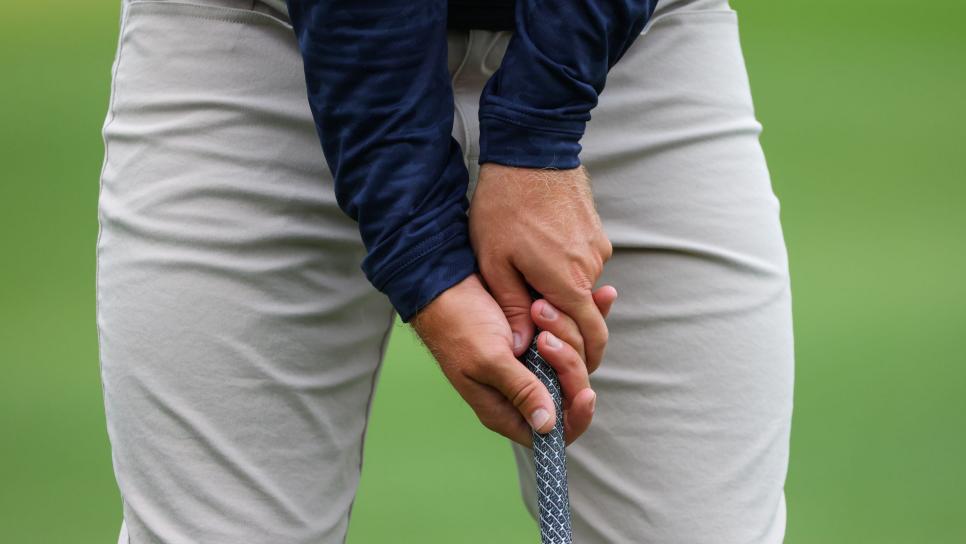Swing your swing
Masters 2023: 'It felt awful': The player who turned a quirky grip into a Masters invite

Ben Walton
AUGUSTA, Ga. — For all the importance placed on the golf club itself, and discussion on how best to move it, a simple reality often falls by the wayside.
That golfers only have one connection to their instrument, and it's through their hands.
For Ben Carr, an amateur who booked his ticket to Augusta courtesy of a runner-up finish at the U.S. Amateur last year, the grip that always felt natural to him isn’t one you’d find in any textbook. It was the product of playing other sports, he says, specifically baseball. He played shortstop and pitched. He never excelled like he would in golf. Instead, he was working just to keep up.
"I was a decent athlete, but always a little undersized," Carr says. "I had to learn to move my body in all these different ways and not be one-dimensional, so I could get the most out of my physical frame."
It felt like he was losing ground at the time, but it was an investment that would soon pay off. Carr had backed into the kind of cross-sport training that has become the new standard for junior golfers. Less specialization, and more improvement in general athleticism.
"If I train you to push, push, rotate then you're going to become a better human, and that's going to make you a better athlete," says Kolby Tullier, a physical trainer who works with Carr and numerous PGA Tour players.
The goal of this approach, ultimately, is to allow these movements to merge together. For the arm strength that baseball helps build, for example, to show up in your golf swing in beneficial ways. It did for Carr, too, who now routinely clocks ball speeds in the 180 mph range despite standing just five-foot-eight and running shy of 180 pounds. But it arrived with one unintended side effect: A slightly unusual grip.
Because swinging a bat at a pitch requires a more rounded movement than an up-and-down golf swing, many golfers who played baseball growing up tend to rotate their hands more onto the side of the club — into a "stronger" position. It feels natural, but it often causes the clubface to close through the ball, and sends the ball hooking left as a result.

Ben Walton
It did for Carr, too. He learned how to turn his hook into a slinging draw over time, but it was at times an uncontrollable one. He liked the distance that came with it, but he knew it was unsustainable. He needed to lessen the curve. The problem was, when he asked coaches to take a look, he wasn’t satisfied with the solution.
"Everyone wanted to get my right hand more on top of the grip and get my left hand a little weaker," he said. "I would do it for the lesson and I would come home and be hitting balls and it just felt awful."
Changing his grip was off the table, because he knew the one he had helped him maximize his distance and, in his own words, helped him "compress" the ball. So he stuck with it, and never with the coaches that told him to change it.
Halfway through his college career at Georgia Southern, Carr linked up with Golf Digest Top 50 Teacher Tony Ruggiero and asked him to take a look. Carr didn't want to change his hold, and Tony had no desire to.

Ben Walton
"He was already a really accomplished, really good player. My job as a coach is to figure out why a player is really good, and help guide them to be even better," Ruggiero says. "Ben was smart. He was focused on the ball flight, and how the changes would affect the way the ball moved in the air. I told him it came down to creating the right match ups.”
Those words, "match ups," would become the key phrase. Simply put, Carr's grip would naturally send the ball to the left, so Carr needed to counteract that with other moves in his swing to create balance. If the grip would send the ball left, he needed something that would send the ball, in theory, to the right, but in practice would mean a straight shot.
For Carr and Ruggiero, that meant creating more rotation in his swing, both on the backswing and downswing, and less side-to-side movement, which would inhibit that rotation. They'd practice grooving that move by placing an object, like a golf bag or bag stand, outside of his trail hip. His goal was to swing full speed, turning as much as he could but never letting his lower body touch the object.
"Everything we've done is to keep his chest turning on the way through, and keep his elbow more in front of his body," Ruggiero says. “He opens his body to square the clubface.”
Eliminating any potential of sliding increased the amount of body rotation. Those moves helped transform Carr's streaky draw into a baby fade, his new stock shot.
"I probably only hit two or three draws a tournament, when I really have to," Carr says. "I used to feel like my arms would take over and I'd hit a hook under pressure. Now I feel like my big muscles help me square the face."
With a little work, Carr soon had the best of both worlds. The comfort of a hold that felt natural to him, the power he needed, and a ball flight that gave him more margin for error. Rather than trying to rid his swing of what felt natural, he learned to compliment it with things he could do. He perfected his swing, and now, he’s got the Augusta National stage to show it to the world.

